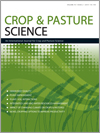Key traits were identified to predict lodging susceptibility of wheat cultivars in the absence of lodging. A new regression model, based on plant height, spike dry weight and the inertia moment of the stem base was validated. The application of this model will be useful for evaluating commercial cultivars and breeding materials and discarding genotypes with high lodging susceptibility, even under conditions of no lodging.

Crop and Pasture Science
Volume 70 Number 2 2019
CP18235Reaction of Australian durum, common wheat and triticale genotypes to Karnal bunt (Tilletia indica) infection under artificial inoculation in the field
 , Pawan K. Singh, Mui Keng Tan, Guillermo Fuentes-Davila, Xinyao He and Ravi P. Singh
, Pawan K. Singh, Mui Keng Tan, Guillermo Fuentes-Davila, Xinyao He and Ravi P. Singh
Karnal bunt is a disease of wheat caused by the fungus Tilletia indica Mitra and is a major biosecurity threat for the Australian wheat industry. This study has identified Australian wheat genotypes with durable resistance to infection. The genotypes provide a basis for breeding adapted varieties that can be recommended for growers, should the pathogen enter Australia and become established.
The importance of anther dehiscence contributing to low-temperature tolerance at the booting and flowering stage in rice was identified. Floral characteristics were examined in controlled temperature glasshouse experiments with strong negative relationships observed between spikelet sterility and anther dehiscence length and number of dehisced anthers. A repeatable phenotyping system was developed and in combination with increased understanding of floral traits will lead to increased efficiency in breeding for low-temperature tolerance in rice.
CP18459Differentiation and evolution among geographic and seasonal eco-populations of soybean germplasm in Southern China

The Southern China soybean germplasm, formed under different geographic and sowing-seasonal conditions, is extremely diverse and potential for world expansion. The study on its flowering-date and sensitivity to geo-seasonal photo-thermal changes integrated with marker-allele structure and distance analysis revealed that its ecological-differentiation coincides with genetic-differentiation and Ecoregion-III summer-sowing type is the most primitive one among the eight geo-seasonal populations. Which supports the hypothesis on Southern China origin of cultivated soybeans.
CP18423Genome-wide association analysis of 1-octen-3-ol content related to soymilk off-flavor in soybean seed
 and Zhikun Wang
and Zhikun Wang
Twenty-one novel QTNs were identified to be associated with 1-octen-3-ol content in soybean seed through 90 diverse soybean accessions and 26822 SNPs. Among them, 13 QTNs overlapped with, or were located in, the linked regions of known QTNs for soybean seed compositions. The candidate genes located in the 200-kb genomic region of each peak SNP were also identified. These QTNs and their candidate information were valuable for future marker-assisted breeding.
CP18436Influence of row spacing and cultivar selection on annual ryegrass (Lolium rigidum) control and grain yield in chickpea (Cicer arietinum)
Annual ryegrass (ARG) is a problematic weed for chickpea in Australia; therefore, effective weed control measure is needed. Grain yield losses were lower when ARG emerged at 3 week after planting. High yield of chickpea and effective control of ARG can be achieved by exploring narrow row spacing and weed-competitive cultivars.
CP18458Performance and weed-suppressive potential of selected pasture legumes against annual weeds in south-eastern Australia
 , Saliya Gurusinghe, Paul A. Weston, William B. Brown, Jane C. Quinn, John W. Piltz and Leslie A. Weston
, Saliya Gurusinghe, Paul A. Weston, William B. Brown, Jane C. Quinn, John W. Piltz and Leslie A. Weston
Results of 3 years of field experimentation using a variety of annual pasture legumes demonstrated that arrowleaf clover and biserrula were the most consistent and competitive annual legumes with respect to stand establishment, yearly regeneration and consistent suppression of common pasture weed species. Multivariate analysis revealed weed suppressive potential of annual pasture legumes including biserrula cv. Casbah and yellow serradella were due to mechanisms other than competition for resources.
CP18258Simulation of productivity and soil moisture under Marandu palisade grass using the CSM-CROPGRO-Perennial Forage model
Crop models are important tools for assisting farmers and crop consultants to make decisions about management practices. The performance of the CSM-CROPGRO-Perennial Forage model to simulate regrowth of Marandu grass was evaluated under soil and climatic conditions in the Cerrado biome of central-eastern Brazil. The results suggest that the model simulates forage growth adequately under different managements of irrigation and N fertilisation.
CP18311Effect of stubble height and irrigation management on the growth, botanical composition and persistence of perennial ryegrass, tall fescue and chicory swards in cool-temperate Tasmania
 , Richard P. Rawnsley, Mark J. Freeman, Ross Corkrey, Keith G. Pembleton, Matthew T. Harrison, Peter A. Lane and David A. Henry
, Richard P. Rawnsley, Mark J. Freeman, Ross Corkrey, Keith G. Pembleton, Matthew T. Harrison, Peter A. Lane and David A. Henry
The profitability of dairying in south-eastern Australia can be improved by increasing summer–autumn pasture production. In a study in cool-temperate north-west Tasmania, perennial ryegrass, tall fescue and chicory achieved higher summer–autumn yields when repeatedly defoliated to stubble heights of 35 or 55 mm cf. 115 mm. When regularly irrigated to correct precipitation deficits, tall fescue showed potential to increase summer-autumn yields beyond that of perennial ryegrass.
CP18313Effect of stubble-height management on crown temperature of perennial ryegrass, tall fescue and chicory
 , Richard P. Rawnsley, Mark J. Freeman, Ross Corkrey, Matthew T. Harrison, Keith G. Pembleton, Peter A. Lane and David A. Henry
, Richard P. Rawnsley, Mark J. Freeman, Ross Corkrey, Matthew T. Harrison, Keith G. Pembleton, Peter A. Lane and David A. Henry
Above-optimal ambient temperatures (≥30°C) challenge summer pasture production in south-eastern Australia. A field experiment showed that defoliating to shorter stubble heights (35 or 55 mm cf. 115 mm) contributed to elevating the crown temperature of three pasture species, which may have negative implications for plant growth and survival during hot summers. Chicory and second-year tall fescue experienced less-extreme crown temperatures than perennial ryegrass, which may partly contribute to the superior growth of chicory and tall fescue in hot summer environments.



